
 In the last few weeks, the Trackside infill project has generated a lot of criticism from residents who live in the Old East Davis and other nearby neighborhoods. The criticism focuses on two points – the lack of outreach by the developers has been cited by several neighbors, and the proposed five and a half story height has led some to question whether the project is within the current design guidelines for the city.
In the last few weeks, the Trackside infill project has generated a lot of criticism from residents who live in the Old East Davis and other nearby neighborhoods. The criticism focuses on two points – the lack of outreach by the developers has been cited by several neighbors, and the proposed five and a half story height has led some to question whether the project is within the current design guidelines for the city.
On Monday, the Vanguard sat down with representatives from the development team, Kemble Pope and Steve Greenfield, in an effort to get their side of the story.
Kemble Pope explained that what went wrong in their initial outreach is that “there is not a clear process and [there is] an unclear set of expectations on how infill development projects are shared with the neighbors while they’re being in the early stages in formulation.”
He was clear that they did not want to engage in a “he said, she said” battle with the neighborhood. “We did reach out to all of our adjacent neighbors,” he said, noting that they have a lot of adjacent neighbors on all sides of the building.
Mr. Pope explained that one of the adjacent residents was a renter and he did not follow up with the owners of the house, who have since moved back in. He acknowledged that that should have been done better.
He explained that the expectations are unclear in that there “is nothing in common that we can all point to and say here’s what you should do, here’s what you’re required to do.”
“We did our best and felt like we had done a pretty good job,” he continued. “We want to look forward, we don’t want to look at the past and play blame games.”
Steve Greenfield explained, “We also envisioned this to be the time of outreach and to show them what we’ve come up with and to get their feedback… We also thought we’d be getting staff feedback at this point from the city – and that process has just started.”
Kemble Pope added, “This was always envisioned as a four month period of the review and feedback from a lot of different stakeholder groups so that we could refine the project to make it better.”
He noted, “There [are] a lot of conflicting priorities.” He said, “Everyone says densify downtown, build up downtown, don’t build on the periphery but there are a lot of priorities at work in the neighborhood.”
The other key criticism is the decision to go up to five and a half stories. They cited both cost considerations and philosophical views about the need to grow up if we are not growing out.
Steve Greenfield explained, “The cost considerations are tied to the parking. If you go three or four stories, it’s really hard to do an adequate job of underground parking or surface parking and still maintain all of the retail space. You need a certain number of units to cover it.”
This, he explained is the reality of the non-redevelopment agency world, where there is limited to no public funding for such infill and redevelopment projects. “No one is giving us any money to build underground parking,” Mr. Greenfield explained.
Right now the plan calls for 51 spaces of underground parking. They have been told by city staff that the project currently meets the need for the number of spaces that would be acceptable.
They explained that parking has constrained how the project could be developed and it led to retail options to be able to afford to do the infill. There have been tradeoffs that have had to happen.
As they explained, a brand new three story housing building with parking at grade would not pencil out.
They explained that ultimately what they wanted to do was build a mixed-use infill project. Their hope was to bring more people to live in the core area in a more urban setting. Their target market is empty-nesters who live in Davis, but whose children have grown up.
They are also targeting young professionals who want a more urban lifestyle and a few of the units are targeting executive residences. They also mentioned visiting professors who are here for a year or two and who may just want to live in Davis a short time.
There has been some miscommunication about the floor plans. Some have inferred that this is a dorm-living scenario, but they stated that these are not meant to be mini-dorms. And while they cannot prevent students from living them, they will require the residents of the unit to pass a credit history themselves and have to qualify in order to live there.
That doesn’t mean students who are independently wealthy can’t live there, but what won’t happen is that wealthy parents rent the units for their children.
They also explained that the term luxury is not a word they would use to describe the project. Concierge has been used, but it is not the right connotation. They explained that they are thinking of an on-site leasing agent sitting in the lobby who can accept packages and the like.
Right now they are looking at a market rate cost, with sizes ranging from 795 to 2000 square feet. There are only two at the maximum size. There are one to three bedrooms in the units.
Six of them are proposed to be less than 1000 square feet, another 16 around 1200 to 1400 square feet. And there are sizes between 1400 and 2000 square feet.
Steve Greenfield explained, “The philosophy is that yes, we feel the downtown needs to go up.” The specific height needs to play out, but they firmly believe that downtown needs to go up.
He referenced the Joint Planning Commission meeting for a few months back where the council said, as recounted by Mr. Greenfield, “We believe the guidelines need to be updated and you guys may see projects coming before you that don’t meet the guidelines and the planning commission (should) weigh in as you must,” but Kemble Pope interjected, “We may have overriding concerns regarding density and redevelopment.
Steve Greenfield also pointed out that “this site is only going to get redeveloped once in our lifetimes.” He said, “This is it so you have to take a long-term picture view as well.”
The question is whether there is a compromise to be reached between the developers, who seem to have a pretty clear and firm vision for this project, and the residents who have very different ideas.
“There’s always a compromise,” Kemble Pope stated. “This is not set in stone. We anticipated that things needed to be changed and refined.” However, he cautioned, “The definition of the word compromise does not always mean that you’re going to meet right in the middle on everything, so the different priorities that are at play have to be weighed judiciously…”
Steve Greenfield added, “We can’t even talk about compromising if they don’t meet with us.” He explained they reached out to the neighbors, explaining that Kemble Pope was out of the country, asking when they could meet.
On June 30, Mr. Pope sent an email to the neighbors stating, “We apologize that our preliminary outreach efforts to our neighbors in the winter and spring of 2015 regarding our proposed redevelopment project did not meet your standards for collaboration.”
He and Mr. Greenfield explained that they have gotten no response so far from the neighbors. They have been told that the neighbors do not want to meet with them, they only want the developers to meet with the Board of the Old East Neighborhood Association – a body which re-constituted itself after the development application was submitted. It had previously been inactive for four or five years.
So, “Is there a compromise?” Kemble Pope stated, “Yes, but we have to sit across the table from each other to begin the process.”
Following our hour-long interview, Kemble Pope and I, for the Vanguard, went to the neighborhood. I took a number of pictures – many of them from I Street, a few from the alleyway and some from J Street. While there are some gaps in the trees on I Street, I think the photos will give a flavor for the type of sightline impacts most of the neighbors are likely to see.

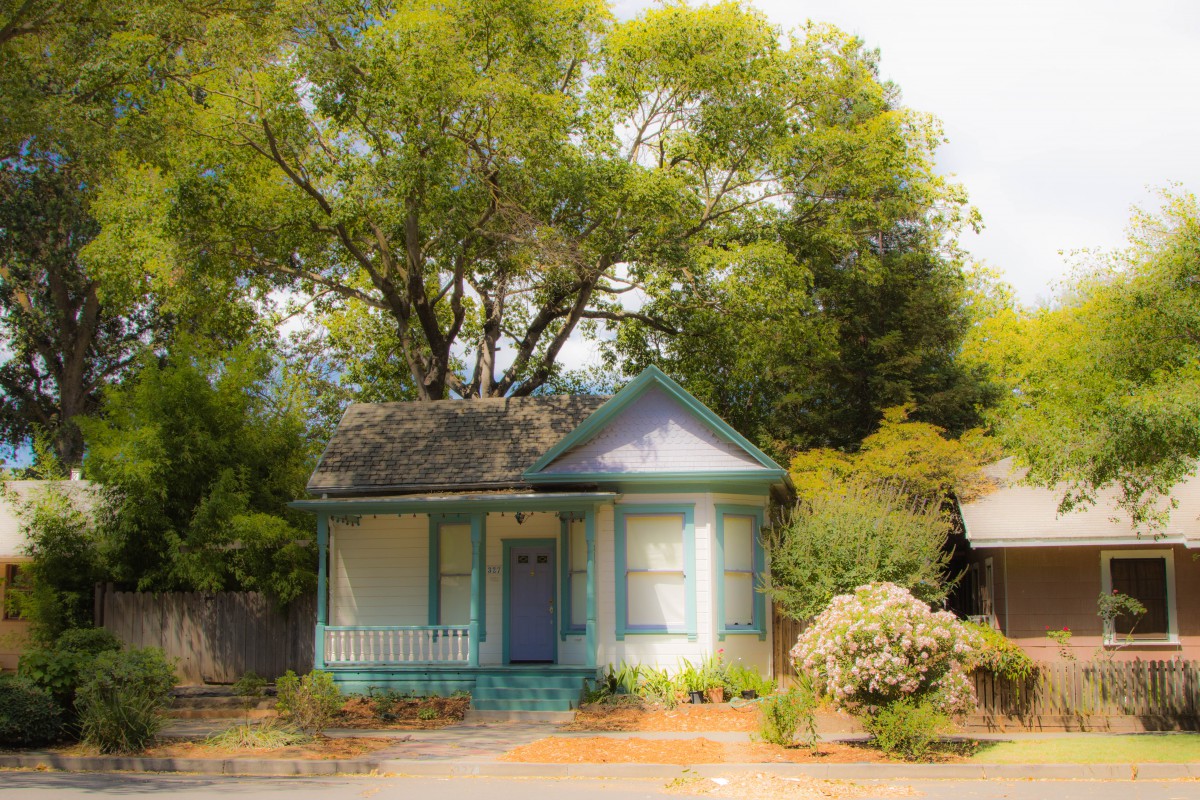
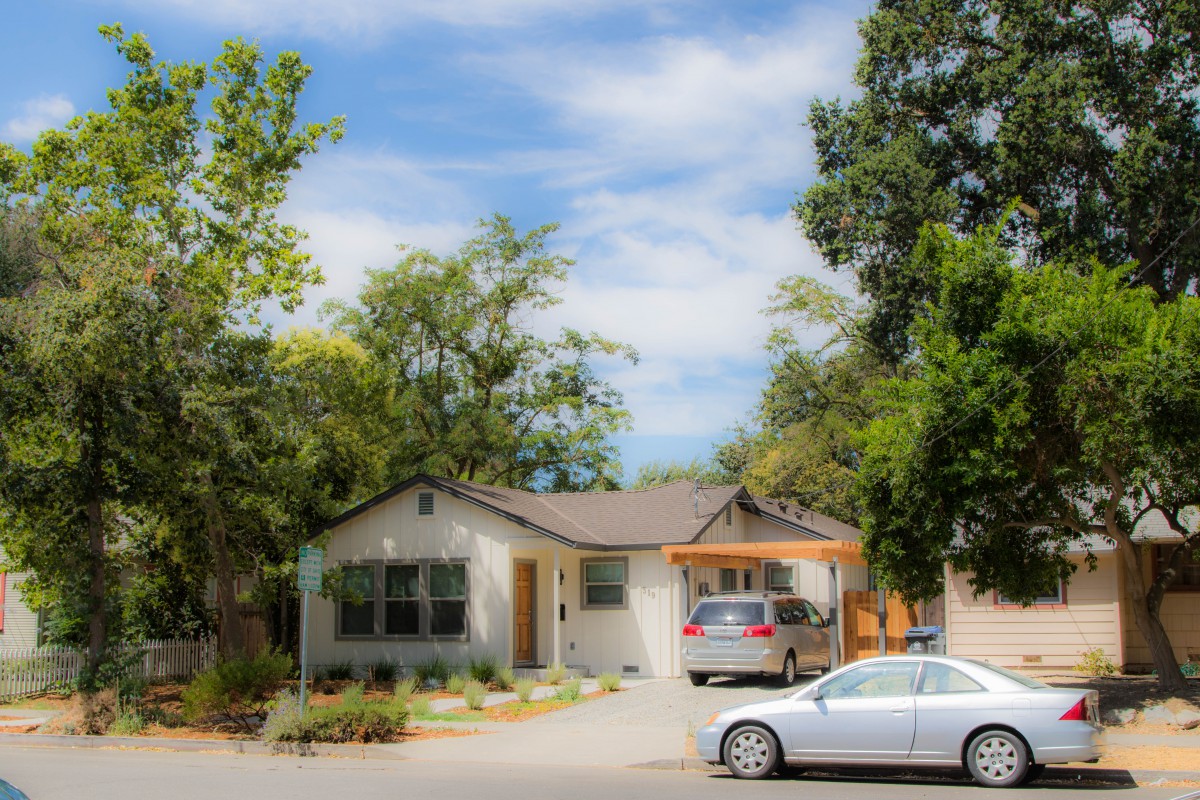
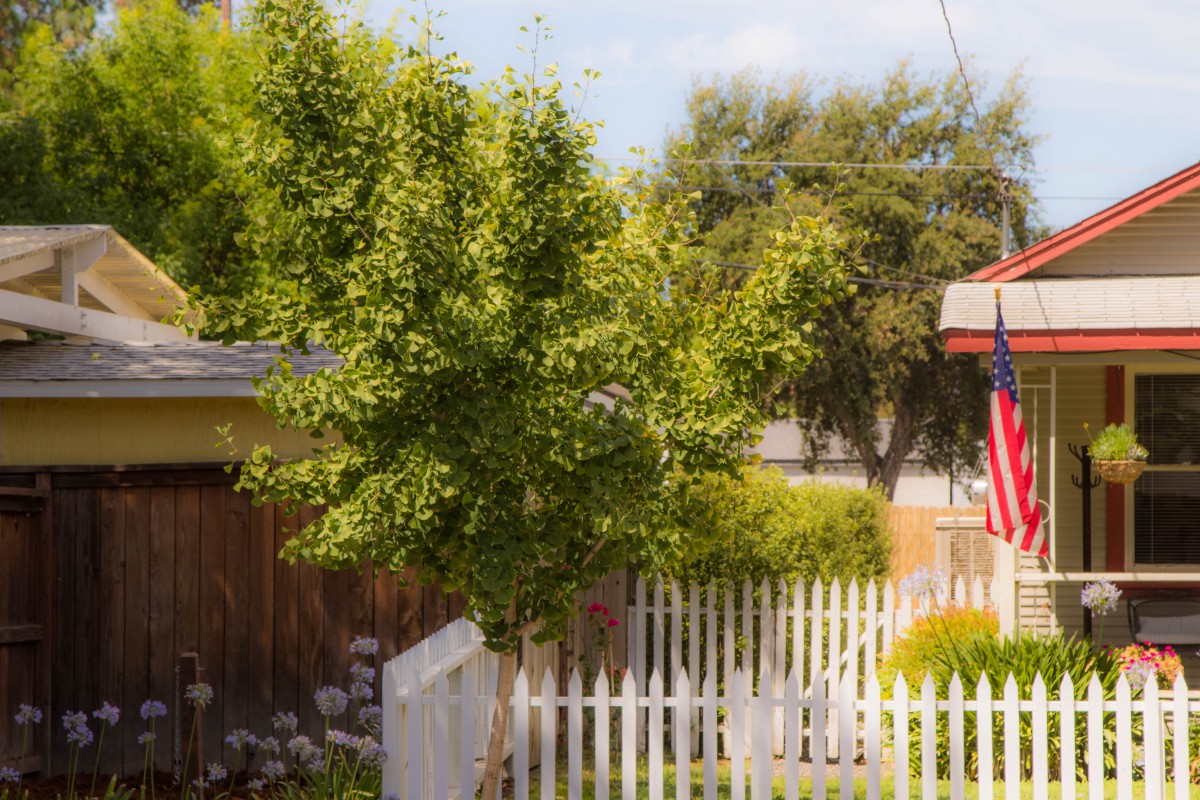


As a comparative, we took photos of the five story parking garage located half a block from the site.


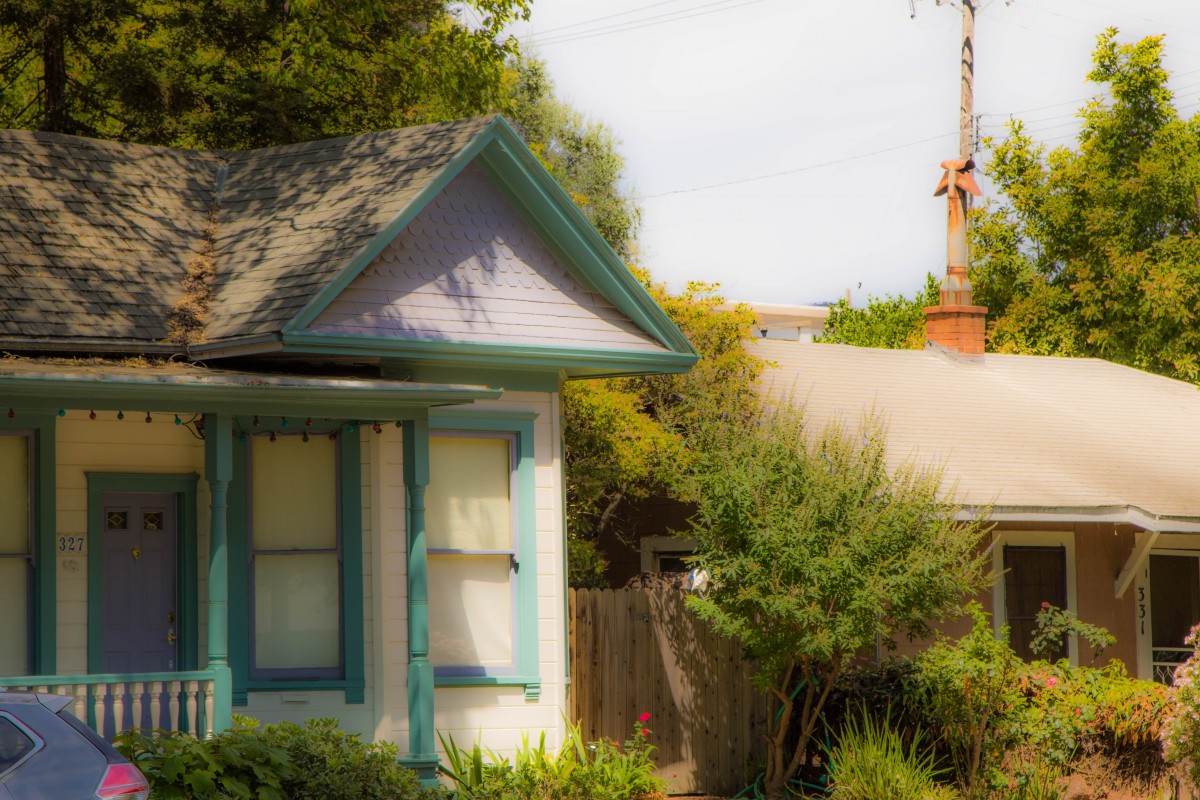
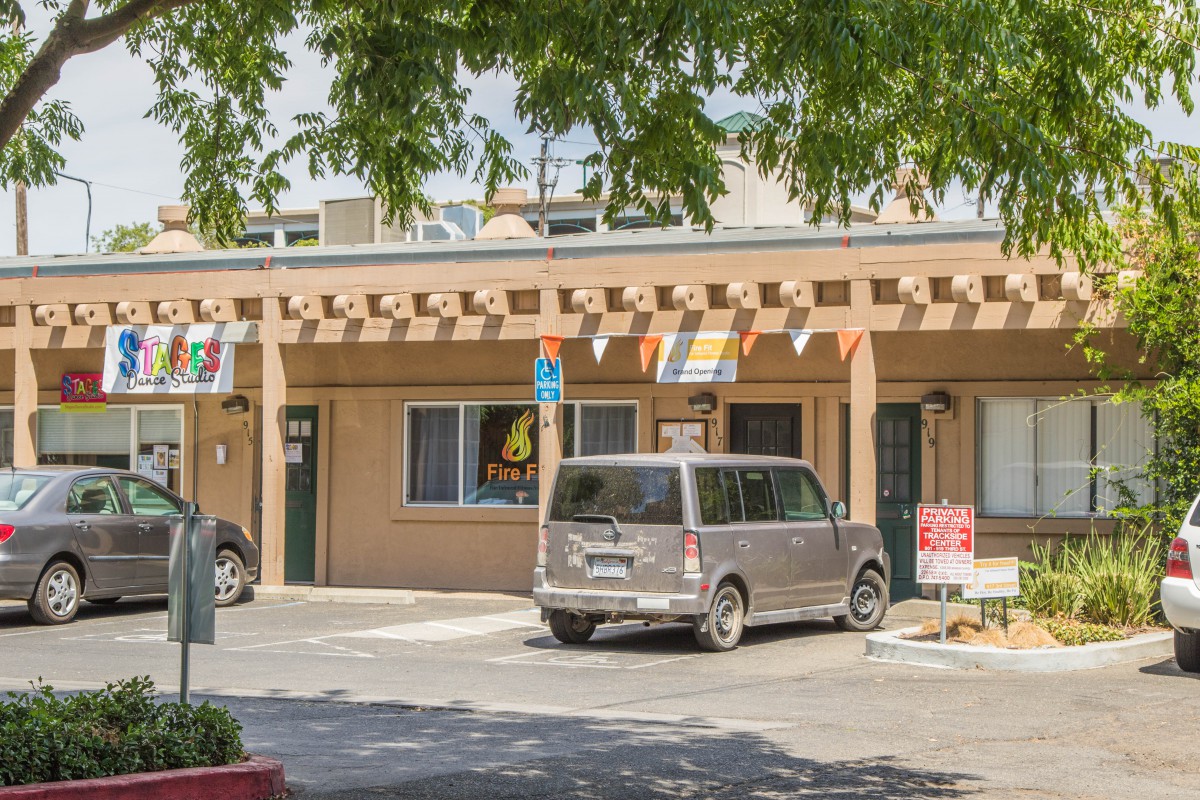
We then went over to J Street to look at potential views.

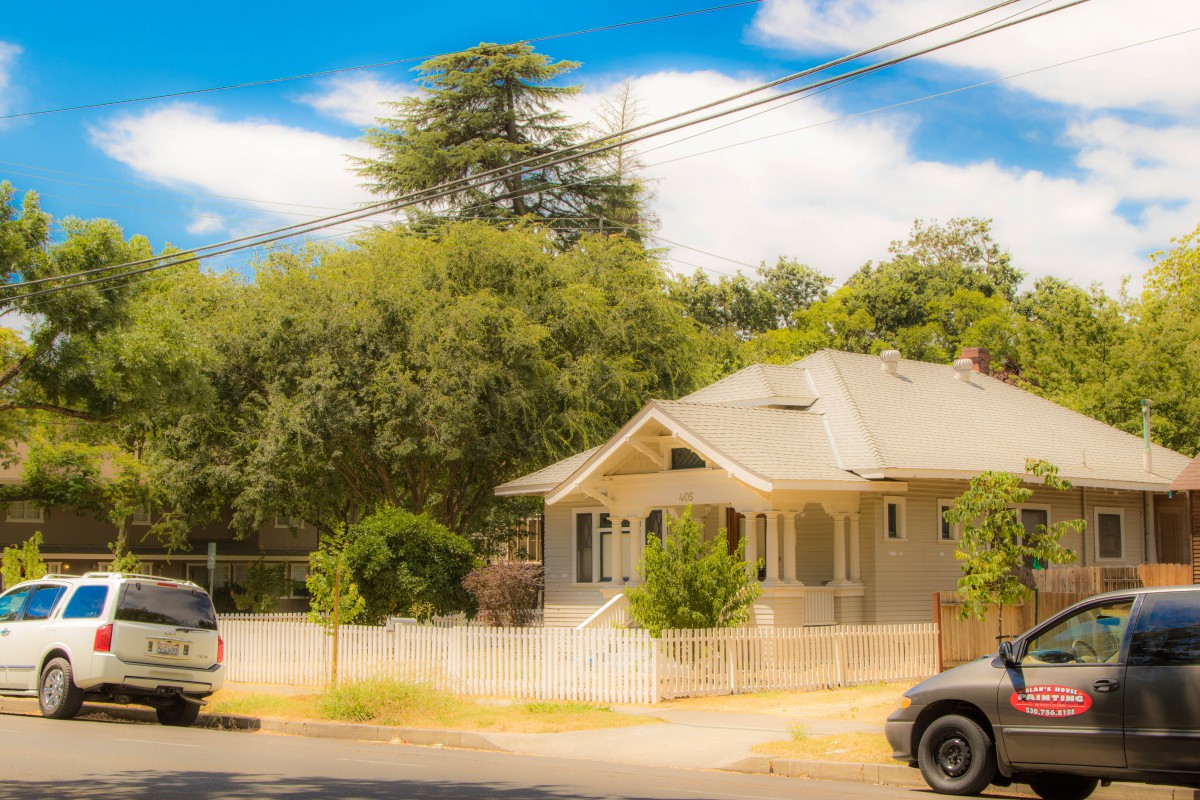
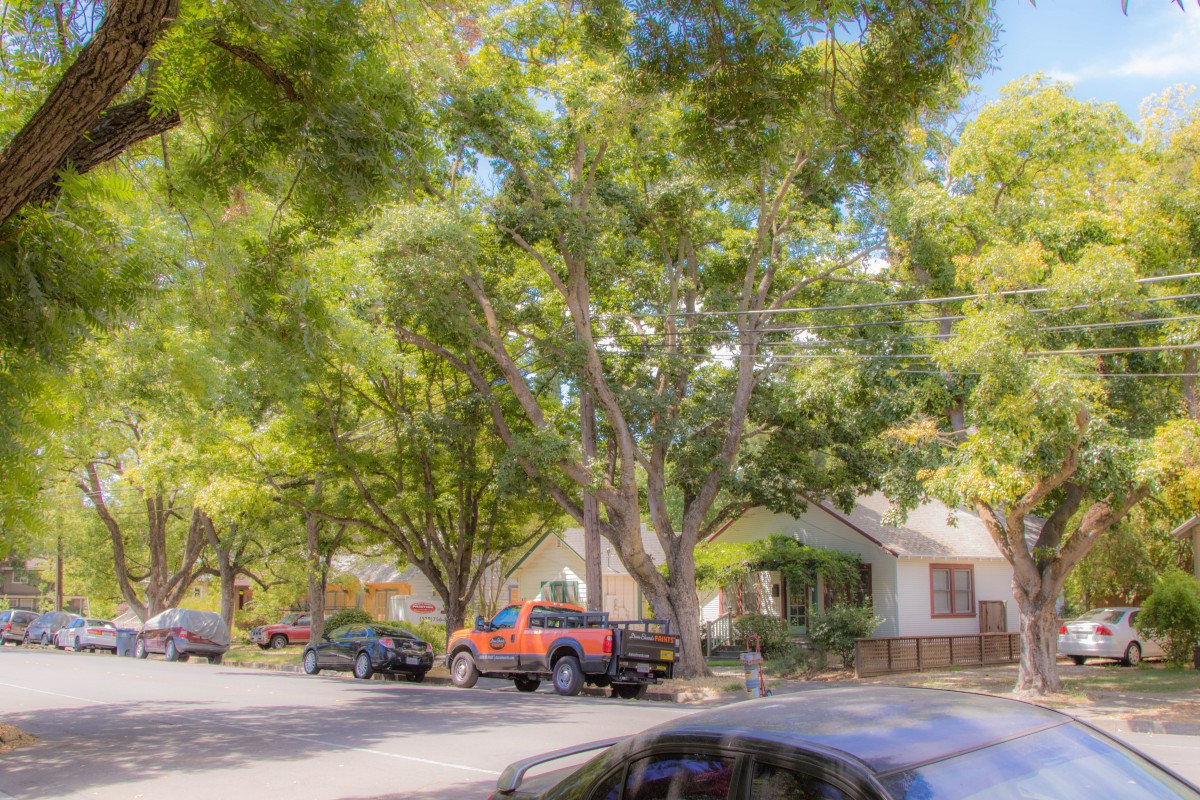
—David M. Greenwald reporting

Many if not most of those trees won’t have leaves for half the year so the building will stand out much more from Oct. through March. I know I wouldn’t want a 5 1/2 story apartment building erected in my neighborhood where the buildings are all one and two stories and I would fight such a project. I stand behind the East Davis residents and feel this project is way too big for the area. How many 5 1/2 story buildings do we even have in Davis?
That’s a good point. My purpose here was to provide additional information about the proposal.
BP: How many 5 1/2 story buildings do we even have in Davis?
The tallest building I can think of, not on the UCD campus, is the Chen Building, which is 4 floors.
the parking garage in the photo is five
To imagine how this project will look from the street to those heading west along 3rd, one has only to take the views above demonstrated from 4th and I of the parking structure, and imagine what a structure of similar height and “boxy” appearance with comparison to the surrounding structures would look like next to the one story homes on the surrounding streets. Pictures of trees not withstanding, the building as proposed will be much more analogous to the parking structure than than the pictures would suggest. So rather than focusing on the trees, imagine that the parking structure has been placed next door to your one story home and you have a more apt description of what is being proposed.
Several references have been made to the need to build up in “downtown”. I agree. However, these comments sidestep the fact that this proposed building is not “downtown” but in a “transitional” area. There is nothing transitional in my mind in moving from one story buildings to a ” 5 1/2″ story building which would be taller than any existing downtown structure.
“the building as proposed will be much more analogous to the parking structure than than the pictures would suggest.”
I may not be a fan of the design, but I have no doubt that the finished building would look much like the Architect’s rendition that the project proponents provided, and that does not look anything like the parking structure a couple of blocks away.
“However, these comments sidestep the fact that this proposed building is not “downtown” but in a “transitional” area.”
This has to be one of the silliest arguments I have read. The project is downtown, regardless of what ‘label’ someone put on a map at some time in the past.
But let’s keep your definition and call it a ‘transitional’ area, then this building becomes the first in what hopefully will be a series of redevelopment projects along third street that transforms the area while expanding the downtown, creating jobs, and expanding our local economy.
why is it not in the downtown? when rail relocation happens there will be no artificial barrier in place and clearly you can see the project as an extension of downtown. even now, it’s a retail zone where housing doesn’t start until the i street area on the other side.
You’re all ignoring the perfect solution for growth: downward. lol.
http://www.tandfonline.com/doi/abs/10.1080/02697459.2011.542061#.VZvoyPkYFXs
;>)/
Not enough given the demand to not grow peripherally. Better get used to it in the core area and near core area.
It seems like mixed-use redevelopment is a pipe dream unless we can get projects like this done. That is the thing about redevelopment, it tends to not match the old neighborhood until the old neighborhood is redeveloped. So if we are going to accept arguments from old neighbors that don’t like it, we should just be honest and admit it cannot be done.
Tia – you are really irritating on this. You oppose just about every idea for peripheral development and claim you want more density. More smaller and condensed living is what you say we need. People don’t need as many material things you say. You say you want there to be no need for cars and everyone can walk and bike to where they need to go.
And here you are opposing a high density redevelopment project that satisfies all your demands… except that you don’t like this either.
And please provide your nuanced argument for why you should not just be labeled as extreme NIMBY and change-averse?
“Tia – you are really irritating on this.”
i understand you don’t agree with her – but can’t you make your case without the personal nonsense? people have no obligation to support your vision of town that means they can oppose all growth.
I was just being frank and honest that someone that posts so often with so much thoughtfulness and so much insistence that we do one thing… but then goes off against that very thing she says we should do… as being very irritating. Is she being disingenuous with her position that the city needs to focus on housing density and keeping in small and dense? It certainly appears so.
So we value farmland so much that we cannot expand the footprint of the city. The argument is that once we develop on farmland it will never be used for farmland again. Well the same is true for land we develop on. If we develop at a certain density we will never be able to increase that density… at least in our lifetime.
I am 10 ft. away from a 2-story neighbor with a steep pitched roof and on a raised foundation. Their home blocks the rising sun, and their windows look right into my back yard and into my home. I had to plant screens for privacy. This home was built after we purchased the lot and built our one story home… and that spec home planned for that adjacent lot then changed to be this taller version when someone purchased the lot from the developer to build a custom home. We had no recourse but to move or get used to it. We got used to it because unless you live in the country with land around you, the neighboring adjacent landowner has rights to develop.
And I live in a 100% zoned residential neighborhood. So what gives these neighbors a right to block new development in a zoned commercial-residential development?
So, if you are someone that REALLY demands this small and dense and car-less existence, put your damn money where your mouth is and support development that does that. Otherwise just admit that you are someone against everything and anything about development. And then at least we can have a frank and honest debate about that.
i think there is a difference between making a conscious decision to move into a home with a set number of conditions and having a change of conditions.
Frankly, correct me if I’m wrong, but I remember you saying that you and your neighbors tried to fight this.
Good memory BP!
We did not “fight” it. We questioned the home owners association on requiring second story “clear story” windows when a home has direct views into a neighbor’s home. In other words, high and long windows that allowed sunlight and can be opened for air, but the sill is up high.
That was a requirement in our first neighborhood on Antelope that John Ott built.
But we could not get the home owners interested since we were some of the last few lots built and everyone was already in.
Note that I am fine with view mitigation to a point.
But the core area is different. I think it is unreasonable for people living in the core to expect limited impacts from redevelopment… unless we are willing to expand our city retail footprint to the periphery.
As it stands today, that downtown land is very valuable for densification.
Well then. If I were her I would be in stronger support of peripheral development to relive the pressure of downtown redevelopment. Because living downtown in the core in mixed-use commercial-residential zoning in a city that has no options other than to grow upwards because it blocks peripheral development… means that larger buildings will go up next door.
Here is one way to look at it. Do the needs of the neighbors trump the needs of the city? Or asked another way, if the neighbors can demand none or limited impacts, then isn’t the alternative to peripheral development… using the existing downtown for greater economic development and densification… just DOA?
Or maybe they could just go to 3 – 4 stories instead of 5, and make more of an effort at mitigation of the views.
but you’re not her and you don’t have the same views or values as she does, so trying to insert yourself into her shoes doesn’t make a lot of sense. again, i don’t see anything inherently wrong with a view of zero growth or very limited growth.
“Do the needs of the neighbors trump the needs of the city?”
but you’re presupposing the needs of the city…
“Or maybe they could just go to 3 – 4 stories instead of 5, and make more of an effort at mitigation of the views.”
so you’re disbelieving that they can’t cost out less than six?
It’s not that I necessarily disbelieve them. They tied that issue to the parking. The city controls the amount of parking required. It is possible that there are compromises that could be made, but I don’t know what all the parameters of that are.
Developers have built many homes and apartments all over Davis at much less than six stories and have been able to make a profit. I can’t speak for Don but I’m a disbeliever. And if it doesn’t cost out at less than six stories than so what? Are we supposed to be held hostage to developers to make sure their projects make a profit? What if they overpaid for the land, are we as a city supposed to make them whole for their mistakes?
i’m not sure that’s a good argument.
first, i agree with you there are other types of developments they could do and cost out. that gets us back to the discussion of need and density though.
second, we are dealing with the post-redevelopment world and so some of those are have been subsidized by funding no longer available.
I think it’s a great argument.
“It’s not that I necessarily disbelieve them. They tied that issue to the parking. The city controls the amount of parking required. It is possible that there are compromises that could be made, but I don’t know what all the parameters of that are.”
but remember the neighbors were complaining that there wasn’t enough parking as there was.
Yes. Maybe they can compromise.
Come on now. Are you going to stand on that flimsy argument? Are you going to just dismiss the city rental vacancy rates and the lack of city revenue derived from business activity? Give me a break here… you are going so far to defend Tia for some reason that you are at risk of joining her on the “arguing out of both sides of your mouth” tour.
no i’m just in the middle on the issue and don’t think tia is being unreasonable at all. i don’t necessarily agree with her on this, but i don’t think it’s an unreasonable position.
“Are you going to just dismiss the city rental vacancy rates and the lack of city revenue derived from business activity? ”
you know where i stand on both issues. the university needs to provide the rental housing and the city should add a peripheral innovation park. can we stop chasing straw men here and get to the crux of it. you act as if you have the monopoly on truth and no one else can differ with your viewpoints.
Can someone explain to me what a “1/2 story” is?
I thought it might be for young children or very short people, but it shows as 11 feet tall in the plans!
half story i think means that the floor does not extend across the full horizontal expanse of the building.
Translation: the proponents have no experience in entitling high density infill.
Trust me, this is not a project for rookies. The investors need to bring in a development team with the requisite experience. Otherwise, there is zero chance of any project happening on this site.
I have to wonder if, during one of the initial meetings with the investors, since they are folks from around here who know Davis, didn’t somebody say, “Wow, six stories? That’s going to be hard to sell…”
as was told to me they didn’t have a concrete plan together when they met with neighbors.
i think you’re right about that. the comments read as a little naive which is strange given the people involved.
How about if it had a ‘green’ roof? Would that make it more acceptable?
that would be interesting, i’ve never seen that extensive a green roof.
Not far away. Calif. Academy of Sciences in Golden Gate Park:
http://www.calacademy.org/exhibits/living-roof
Don
“How about if it had a ‘green’ roof? Would that make it more acceptable? “
I don’t know about more acceptable…..but it would certainly be more innovative.
Innovative? Think not… There’s at least one in Village Homes that’s at least 15-20 years old.
Think also “Little House on the Prarie” Sod/”green” roofs are OLD. Actually, hundreds/thousands of years old. But then again, the first use of tidal power, to run a grist mill, goes back to France, during the reign of Charlemagne. ‘There is nothing new under the sun’.
These are the primary goals for mixed-use development:
greater housing variety and density
reduced distances between housing, workplaces, retail businesses, and other destinations
more compact development
stronger neighborhood character
pedestrian and bicycle-friendly environments
These are the goals often pushed by some of those in strong opposition to the proposal.
It also appears that the average residential lot size in old east Davis as well as most of the old core are quite a bit larger than are the newer residential lots. Are these residents not being selfish and unreasonable in their expectations given this? If land is so scarce in Davis and they are the beneficiaries of a larger slice, then shouldn’t they at least be expected to allow more efficient land use around them?
Just Google images of “Mixed Use Development” and see what comes up. Most of the images look very similar to the Trackside development rendering.
For the central commercial district there are no height restrictions in code. Given that residential properties are adjacent to central commercial district properties, don’t the residents of the core area need to plan for higher buildings next door?
What is the zoning for the lots where this new development would go? Will it require a zoning exception?
There’s a pretty widespread rumor that Bisch is no longer a Managing Partner or part of the project. Does this confirm the rumor? Any comment on the related rumor that some investors have dropped out?
I think I remember that the original management team reported in the Enterprise was Pope, Bisch, and Greenfield.
What is the definition of a development penciling out? Is it breaking even on their investment? Is it a 10% return on their money? 20%? 50%? 100%?
Should a development pencil out from day one? Or sometimes does it take years before a project pencils out?
My son bought a town home in the SF peninsula as an investment where initially his costs were more than he could rent the unit for. So one might say his investment didn’t pencil out. But do to the rise in rents in the Bay Area 3 years later he’s renting the unit for a nice profit, so one might now say his initial investment did pencil out.
So as you can see ‘pencil out’ or ‘cost out’ are both relative terms. So I very skeptical when a developer states their needs in order to cost out.
BP, “pencil out” for a multi-unit housing development generally requires positive cash flow, not the expectation of asset appreciation… at least not primarily. If you are an investor in a multi-unit housing development, you certainly are not going to want to be on the hook for an ongoing operational shortfall while you hope and wait for the asset to appreciate so you can liquidate. The idea is that the rental income beats the ROI that you could get investing in similar risk alternatives. Otherwise why do it?
So Frankly, are you in the camp that we as a city should make sure that a developer’s project should have positive cash flow from inception? That they should be able to build whatever they need to build in order for them to be profitable from the beginning? That they should be able to build up and as densely as needed and what the local neighbors feel shouldn’t have much bearing?
If a project has to pencil out as far as the city looks at it we should all be lining up and buying any available property because we can’t lose.
I wish I could buy stocks that had a guarantee of a built in profit.
BP – If you are going to develop something you either need to fund it with existing cash or debt or a combination. It is capital investment. Once the project is complete and starts operating it starts providing a return on that capital investment. If the project was funded by debt, then the return from rents would need to exceed the cost of debt service. If funded by the savings of investors, then the return from rents would need to exceed the return that the investors could otherwise get investing in other things. Otherwise the investors would do the other things.
The expectation of appreciation is a long-term hope that is fraught with high risks (as the millions of property owners will tell you 2008-2010).
Now, I suppose one model is that rents increase over time and so the project can have a negative return for a while until rents increase and it moves to a positive return. But then you are talking about the investors having to continue to put more money into the project to supplement operating costs. I don’t know of many multi-unit housing projects where the investors expect a negative return and continued investment waiting for rents to increase and/or the asset to appreciate. Most people that invest in real estate to rent want to see at least a break-even when they start. Unless it is a vacation property that is rented part of the time and then used part of the time.
Okay Frankly, what then should be the return on the investor’s money? Should they as I stated before expect a 10% or 50% or 100% return on their money? Should we as a city let them build a project with a guaranteed return on their money of let’s say 50%?
BP – I would have to see all the numbers, but a project like this with all the code requirements, building permits, union labor, etc… will cost many million. If you have many million in your bank account to invest in this project, you should easily be able to go out and get a 5-6% return on that money without excessive risk. In fact, with that much cash you would command a premium return and probably do much better these days.
So, if you can’t get a similar return on this project you would likely not invest in it.
The “pencil out” requirement would be that this project generates a return on capital at least equal to alternative investments with a similar risk profile.
I would be surprised if it could return 10%. I would expect it to be more like 4% or 5% plus the long-term expectation that the asset would appreciate. There is also some tax benefit for depreciation. All the investors would get a K1 every year that includes any distributions minus operating costs and depreciation expense, etc. But if their net return isn’t good enough to match alternative investments, a project like this just won’t happen as a complete private-financed opportunity.
Now, in some cities there would be public funds injected to help make a project feasible that would otherwise not pencil out. But since the good old Governor Brown killed RDA to give more stuff to the teachers union, that is much more unlikely these days.
Considering the risk, I’d hope for an 8-10% return or more (but I’m the novice here), plus the LT asset appreciation.
Can someone please address the commercial angle. Are retail rents higher than luxury apartment rents, and does this explain why they were added to the development?
And is a private developer really required to use union labor? If they have a licensed GC and worker’s comp / insurance, can’t they freely hire non-union workers? Being Davis, and California construction, won’t there be a lot of illegal (undocumented) labor on the project, upping the profit for the investors?
hpierce
“Innovative? Think not… There’s at least one in Village Homes that’s at least 15-20 years old.”
Good point hpierce. Just because something is unusual in Davis does not make it “innovative” as I had pointed out for some of the supposedly “innovative” features of the Cannery. Thanks for the “consistency check”. I stand corrected.
The proposed 5.5 stories could be strategy; propose 5.5 when what they really want is 4 or 3.
I’m with Don here. How about 3 stories on the street side, and 4 stories on the alley side? This would allow for a terrace for the penthouse units, and a softening of the development.
Along with the parking garage, the cost of a (possibly required) elevator can be an important cost. What does a residential elevator cost today? $500,000, $600,000, more? If code requires an elevator at 3 or 4 stories (what is the requirement?), they may see an extra story as a way to recoup some of those costs.
In my eyes the design sucks. It is cold, and doesn’t evoke the community or warmth, just like the parking garage. For all of our yammering and planning, that is another cold structure. (When was it built?) Palo Alto, West LA, Walnut Creek and other places know how to build warm, inviting structures. A few small pergolas, some creeping vines, and some faux brick can soften a parking garage. For all the money involved, a large mature tree (or two) could always be strategically added to the design… but I’m sure there will be a city referendum on what type of mature tree to plant. … Same for this mixed-use proposal. Where is the wood and / or warmth? This screams South of Market, not funky college town with ag roots.
I would hope they look at the cost / benefit of adding solar power and / or even geothermal capabilities, if there is a reasonable cost. (I’m not suggesting they lose their shirts to appease the greenies.) Is there also a way to funnel rain water into the water table at a reasonable cost? (Ditto.)
I’m curious, are there substantial green add-ons to this project? Solar? Tankless water heaters? Etc………?
I’m not sold on tankless, but I’m told solar pays off long term, and costs less when it is done along with original construction.
David Greenwald or someone who might know, what green technology is in the planning for Trackside, if any?
1998, or thereabouts.